1973 AMC Javelin, a name that evokes images of sleek styling and potent performance, emerged onto the automotive scene during a turbulent era. The early 1970s saw a shift in American culture, with the Vietnam War casting a long shadow and the energy crisis looming on the horizon.
Amidst these challenges, American Motors Corporation (AMC) sought to carve out a niche for itself in the muscle car market, and the Javelin was its bold statement.
The Javelin, with its distinctive fastback design and available V8 engine, offered a potent combination of style and power that appealed to enthusiasts seeking a more affordable alternative to the established Detroit giants. It was a car that dared to be different, capturing the spirit of a generation grappling with change and uncertainty.
The 1973 AMC Javelin: A Rebellious Spirit in a Time of Change
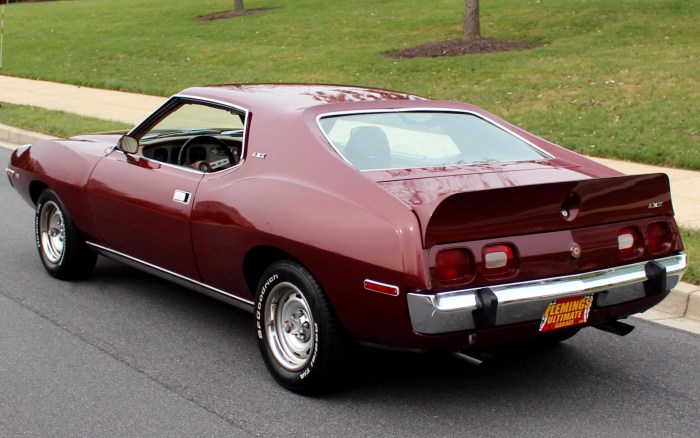
The 1973 AMC Javelin, a sporty coupe produced by American Motors Corporation (AMC), emerged during a turbulent period in American automotive history. The early 1970s were marked by a confluence of economic challenges, including the 1973 oil crisis, and a growing awareness of environmental concerns.
These factors significantly influenced consumer preferences, shifting the focus towards fuel-efficient and smaller vehicles. The Javelin, however, remained a defiant symbol of American muscle car spirit, offering a compelling alternative to the dominant Detroit giants.
The 1973 Javelin: A Blend of Performance and Practicality
The 1973 Javelin, despite its sporty nature, reflected the evolving automotive landscape. It was offered with a range of engines, including the fuel-efficient 258 cubic inch six-cylinder, alongside more powerful V8 options. This versatility catered to a diverse customer base, balancing performance with practicality.
The Javelin’s design, a blend of sharp angles and muscular lines, embodied the rebellious spirit of the era, while its interior offered a comfortable and well-equipped space for its occupants.
Design and Engineering
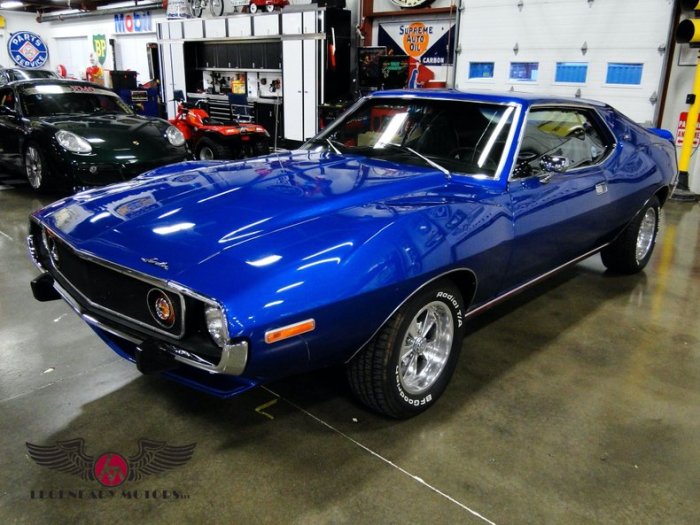
The 1973 AMC Javelin, despite its compact size, was a bold statement in the automotive landscape. Its design and engineering reflected AMC’s ambition to create a car that was both sporty and practical, appealing to a younger generation seeking something different from the established brands.
Exterior Design
The Javelin’s styling, penned by Richard Teague, was characterized by sharp lines and a distinctive fastback silhouette. The long hood, short rear deck, and wraparound windshield gave the car a sporty and aggressive stance. The prominent grille, with its horizontal bars and AMC emblem, was a defining feature, adding to the car’s visual appeal.
The 1973 AMC Javelin, while sporting a more angular design than its predecessor, still retained the sporty spirit that made the model popular. This was evident in the powerful V8 engine options, including the iconic 401 cubic inch unit.
However, it was the 1971 AMC Javelin that first introduced the iconic “AMX” trim , which emphasized performance and handling. This legacy of sporty design and powerful engines continued to define the Javelin through its later years.
The Javelin’s design was a departure from the more conservative styling of its competitors, such as the Ford Mustang and Chevrolet Camaro.
Engine and Transmission
The 1973 Javelin offered a range of engines, catering to different performance preferences. The base engine was a 232 cubic inch (3.8-liter) straight-six, producing 140 horsepower. A more powerful 304 cubic inch (5.0-liter) V8 was also available, generating 150 horsepower.
For those seeking even more power, the optional 360 cubic inch (5.9-liter) V8, delivering 225 horsepower, was a popular choice. The Javelin’s engines were paired with a variety of transmissions, including a three-speed automatic, a four-speed manual, and a four-speed manual with a Hurst shifter.
Suspension and Handling
The Javelin’s suspension system, featuring coil springs and shock absorbers, provided a comfortable ride and good handling characteristics. The car’s front suspension used a MacPherson strut design, while the rear suspension employed a live axle with leaf springs. The Javelin’s handling was praised by reviewers for its responsiveness and agility, making it a fun car to drive.
The 1973 AMC Javelin, with its sharp styling and powerful engine options, was a popular choice for performance enthusiasts. While the Javelin offered a sporty edge, AMC also catered to those seeking a more luxurious experience with the 1970 AMC Ambassador , a full-size sedan known for its comfort and spacious interior.
The Javelin, however, remained a favorite for its agile handling and distinctive design, cementing its place in American automotive history.
Comparison with Competitors
Compared to its contemporaries, the 1973 Javelin offered a unique blend of style and performance. While the Mustang and Camaro were known for their powerful engines and sporty handling, the Javelin stood out with its distinctive design and more affordable price point.
The Javelin’s compact size and maneuverability also made it a practical choice for city driving, unlike its larger competitors.
Performance and Handling
The 1973 AMC Javelin was a muscle car that aimed to provide a balance of performance and handling, offering a compelling driving experience for its time. Its performance capabilities were determined by the available engine options, while its handling was influenced by its suspension design and overall chassis dynamics.
Performance Capabilities
The 1973 Javelin came with a range of engine options, catering to different performance preferences. The base engine was a 258 cubic inch (4.2-liter) inline-six, producing 140 horsepower. For those seeking more power, the 304 cubic inch (5.0-liter) V8 offered 150 horsepower.
The top-of-the-line option was the 401 cubic inch (6.6-liter) V8, which delivered a potent 245 horsepower.The 1973 Javelin’s acceleration varied significantly depending on the engine chosen. The base six-cylinder engine provided modest acceleration, while the 304 V8 offered a noticeable improvement.
The 401 V8, with its substantial power output, delivered the quickest acceleration. However, precise acceleration figures are not readily available for all engine options.Top speed was also influenced by the engine choice. The 401 V8-powered Javelin was capable of reaching a top speed in the range of 120-130 mph, making it a respectable performer for its time.
Fuel efficiency was a concern in the early 1970s, and the 1973 Javelin’s fuel economy was considered average for its class.
Handling Characteristics
The 1973 Javelin featured a front suspension with coil springs and an anti-roll bar, while the rear suspension utilized leaf springs. This combination provided a balance of ride comfort and handling. The car’s handling was generally praised for its responsiveness and predictability, allowing drivers to confidently navigate corners.The Javelin’s steering was considered precise and provided good feedback to the driver.
The car’s overall balance and weight distribution contributed to its handling prowess. However, some critiques pointed to a tendency for the Javelin to understeer in tight corners, especially when pushed hard. This characteristic could be attributed to the car’s relatively high center of gravity.
The 1973 AMC Javelin was a sporty coupe that captured the hearts of many with its sleek design and powerful engine options. While the Javelin was known for its performance, AMC also offered a more family-friendly option in the form of the 1977 AMC Hornet.
This compact sedan offered a comfortable ride and fuel efficiency, appealing to a broader audience. Despite their differences, both the Javelin and the Hornet showcased AMC’s commitment to innovation and diversity within the American automotive landscape.
Racing Heritage
The AMC Javelin had a notable presence in motorsport, particularly in the Trans-Am Series. The car’s performance and handling characteristics made it a competitive contender on the track.
The 1971 Javelin AMX, driven by Mark Donohue, secured the Trans-Am Championship for AMC, marking a significant victory for the brand.
The Javelin’s success in Trans-Am racing helped solidify its reputation as a capable and exciting sports car, contributing to its popularity among performance car enthusiasts.
Interior and Features
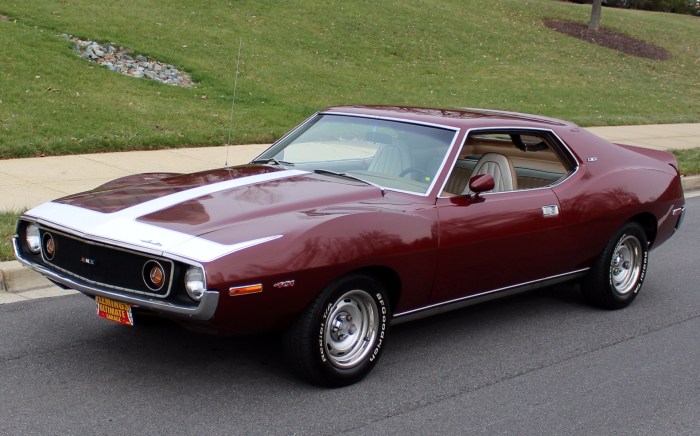
Stepping inside the 1973 Javelin, drivers were greeted with a sporty yet comfortable cabin that reflected the car’s rebellious spirit. While the interior design wasn’t as luxurious as some of its competitors, it offered a blend of practicality and style that appealed to a wide range of buyers.
Interior Design and Materials
The 1973 Javelin’s interior featured a driver-oriented layout, with a prominent instrument panel and a well-placed gear shifter. The dashboard was typically finished in vinyl, with woodgrain accents adding a touch of sophistication. The seats, often upholstered in cloth or vinyl, provided adequate comfort for both driver and passengers.
The overall design emphasized functionality, with a focus on ergonomics and visibility.
Standard and Optional Features
The 1973 Javelin came standard with a range of features designed to enhance both comfort and convenience. These included:
- Power steering
- AM radio
- Heater and defroster
- Full instrumentation
A variety of optional features were available, allowing buyers to customize their Javelin to their liking. Some of the most notable options included:
- Air conditioning
- Power brakes
- Vinyl roof
- AM/FM radio
- Tinted glass
- Rear window defroster
- Custom interior packages
Comparison to Competitors
Compared to its competitors in the sporty coupe segment, such as the Ford Mustang and Chevrolet Camaro, the 1973 Javelin offered a similar level of interior comfort and features. However, some of its rivals boasted more luxurious appointments and a wider range of options.
For example, the Mustang offered a wider selection of interior trim levels and materials, while the Camaro provided more advanced technology features, such as a tachometer and a trip odometer.
Legacy and Impact
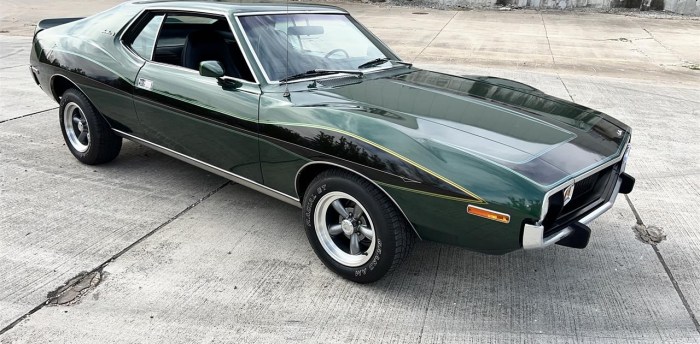
The 1973 AMC Javelin, while not a commercial juggernaut, left an indelible mark on the automotive landscape. It was a symbol of American muscle car rebellion, a defiant statement against the rising tide of fuel-efficient compacts. Its legacy is intertwined with the evolution of the muscle car genre, the changing social and economic climate of the early 1970s, and its enduring appeal among collectors and enthusiasts.
The Javelin’s Lasting Contributions
The 1973 Javelin contributed significantly to the evolution of the muscle car genre. It was one of the first muscle cars to embrace a more refined and sophisticated design aesthetic, moving away from the raw, brute-force image of its predecessors.
Its sleek, aerodynamic styling, inspired by European sports cars, paved the way for a new generation of muscle cars that emphasized both performance and style.The Javelin also introduced several innovative features that would later become commonplace in the industry. Its independent rear suspension, for example, was a rarity in muscle cars at the time, providing superior handling and ride quality.
Its optional AMX package, with its powerful V8 engine and aggressive styling, further cemented the Javelin’s place as a performance icon.
The Javelin’s Shortcomings
Despite its innovations and strong performance, the Javelin faced several challenges that ultimately hindered its commercial success. Its relatively high price point, compared to its competitors, made it less appealing to budget-conscious buyers. Additionally, its fuel economy, a growing concern in the wake of the 1973 oil crisis, was not as competitive as its smaller, more fuel-efficient rivals.
The Javelin’s Enduring Appeal, 1973 AMC Javelin
Despite its commercial struggles, the 1973 Javelin has found a dedicated following among collectors and enthusiasts. Its unique blend of performance, style, and affordability makes it a highly desirable classic car. Today, well-preserved examples of the Javelin, particularly those equipped with the AMX package, can fetch impressive prices at auctions and collector car events.The Javelin’s enduring appeal is a testament to its rebellious spirit and its ability to capture the zeitgeist of a turbulent era.
It remains a symbol of American muscle car innovation and a reminder of the era when performance and style were paramount.
Final Review: 1973 AMC Javelin
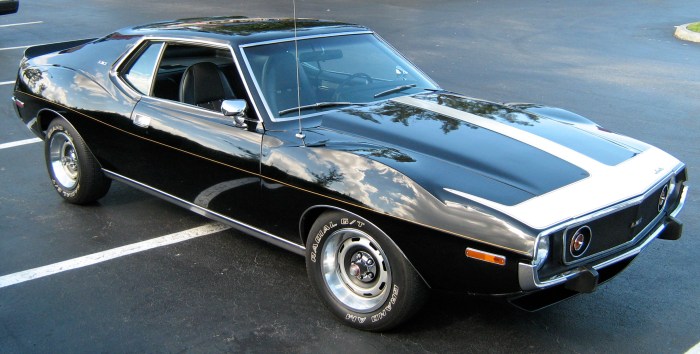
The 1973 AMC Javelin, despite its relatively short production run, left a lasting impact on the automotive landscape. Its innovative design, performance capabilities, and affordability made it a compelling option for buyers seeking a unique and engaging driving experience.
While its legacy may be overshadowed by its more celebrated contemporaries, the Javelin’s story serves as a reminder of AMC’s ambition and its ability to challenge the status quo. For collectors and enthusiasts, the 1973 Javelin remains a testament to the enduring appeal of American muscle cars, offering a glimpse into a bygone era of automotive innovation and excitement.